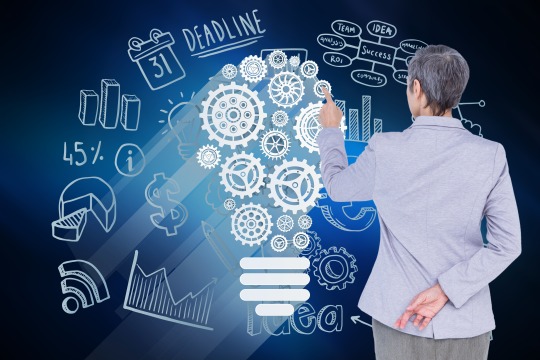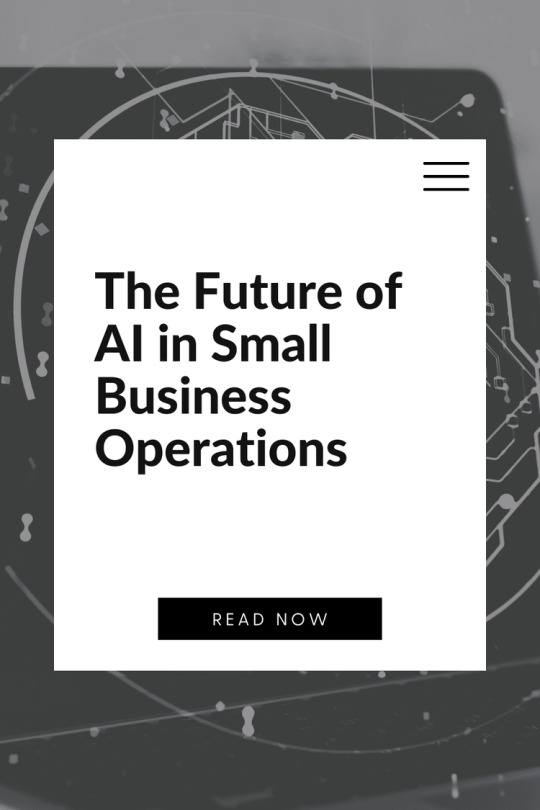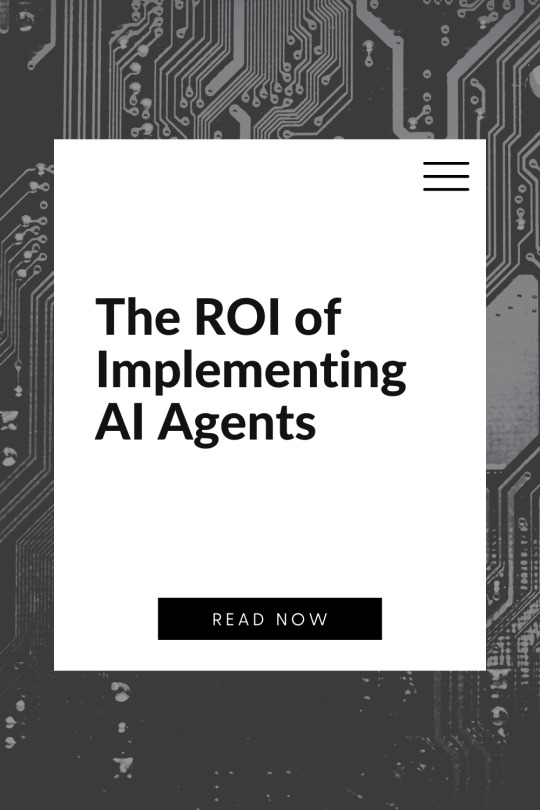#intelligent workflow
Explore tagged Tumblr posts
Photo

Mastering Efficiency: The Power of Intelligent Workflows
In today's fast-paced world, businesses and individuals alike are constantly seeking ways to optimize productivity and streamline their operations. One effective solution that has emerged is the implementation of intelligent workflows. By leveraging advanced technologies such as artificial intelligence (AI) and automation, this enables organizations to enhance efficiency, reduce errors, and achieve remarkable results.
Intelligent workflows represent a systematic approach to managing tasks, processes, and information within an organization. Unlike traditional workflows that rely heavily on manual intervention and repetitive tasks, this leverage technology to automate and optimize processes.
By integrating AI, machine learning, and data analytics, organizations can transform their operations into highly efficient and intelligent systems. Automation is the key to this workflow. By automating routine and repetitive tasks, organizations can save valuable time and resources while minimizing the potential for human error. This allows employees to focus on more strategic and creative aspects of their work, leading to higher productivity and job satisfaction.
Intelligent workflows integrate various systems and tools within an organization. By connecting disparate software applications and databases, data can flow seamlessly across different departments, eliminating silos and enabling real-time collaboration. This integration leads to improved visibility, streamlined communication, and a clear view of operations. intelligent workflow
#intelligent workflow#intelligent workflow automation#smart workflow automation#standard workflow and intelligent workflow
0 notes
Text

The Future of AI in Small Business Operations
Artificial Intelligence (AI) is no longer a futuristic concept reserved for tech giants and large enterprises. Small businesses are increasingly leveraging AI-powered tools to streamline operations, improve customer experiences, and drive efficiency. As technology continues to advance, AI's role in small business operations is expected to grow exponentially.
How AI is Reshaping The Way Companies Operate
1. Automating Routine Tasks
One of the most significant advantages of AI for small businesses is automation. AI-driven tools can handle repetitive administrative tasks such as data entry, invoicing, scheduling, and customer service responses. Chatbots, for instance, can provide 24/7 customer support, freeing up human employees to focus on higher-value tasks.
2. Enhanced Customer Experience
AI is transforming customer interactions by providing personalized recommendations, chat assistance, and predictive analytics. Small businesses can use AI-powered CRM systems to analyze customer behaviour and deliver tailored experiences. Voice assistants and AI chatbots will become even more sophisticated, enabling businesses to engage with customers in a more natural and responsive manner.
3. Data-Driven Decision Making
Data is a crucial asset for any business, and AI is making it easier for small businesses to analyze and interpret vast amounts of information. AI-powered analytics tools can help businesses identify market trends, customer preferences, and operational inefficiencies. By leveraging AI for data insights, small businesses can make informed decisions that drive growth and profitability.
4. AI-Powered Marketing Strategies
AI is revolutionizing marketing for small businesses by automating and optimizing campaigns. AI-driven tools can analyze customer data, predict trends, and create targeted advertisements. Businesses can use AI-powered email marketing platforms, social media management tools, and content generation software to enhance their digital marketing strategies with minimal effort.
5. Smarter Inventory and Supply Chain Management
AI can optimize inventory levels, predict demand, and automate supply chain operations. Machine learning algorithms can analyze sales patterns and suggest the best time to restock products, reducing waste and improving efficiency. Small businesses using AI for inventory management will minimize costs and avoid stock shortages or overstocking.
6. Cybersecurity and Fraud Prevention
As small businesses continue to digitize their operations, cybersecurity threats become a growing concern. AI-powered security solutions can detect and prevent fraudulent transactions, identify vulnerabilities, and protect sensitive customer data. AI-driven cybersecurity tools will become essential in safeguarding businesses against cyber threats and data breaches.
7. AI-Driven Hiring and HR Management
Recruiting the right talent is crucial for small businesses, and AI is transforming the hiring process. AI-powered HR platforms can analyze resumes, conduct initial screenings, and even predict candidate success based on historical data. Additionally, AI tools can assist with employee engagement, performance tracking, and workforce optimization.

“Small and medium businesses have historically been at a disadvantage when competing with larger enterprises. No matter how much they’ve leaned on things like personalized service or niche product offerings, smaller companies have always faced a lack of resources that creates barriers to competitive growth — barriers that are quickly disintegrating thanks to the rapid evolution of technology.”
— Rashan Dixon, Sr. Business Systems Analyst at Microsoft
Industries Benefiting from AI
AI is making a direct impact on specific industries, revolutionizing how small businesses operate and compete.
Healthcare: AI-powered diagnostic tools are improving disease detection, while automated patient scheduling and AI-driven virtual assistants enhance operational efficiency for small clinics and telemedicine providers. Predictive analytics also helps in patient care management and treatment planning.
Retail & E-commerce: AI-driven chatbots assist customers in real-time, while predictive analytics optimize inventory and supply chain operations. Personalized AI recommendations increase customer engagement and sales conversions for small retail businesses.
Finance: AI-based fraud detection tools protect small financial firms from cyber threats, while automated bookkeeping and financial planning software streamline financial operations, improving accuracy and efficiency.
Hospitality: AI-powered booking systems and dynamic pricing strategies help small hotels and travel agencies maximize occupancy and revenue. AI chatbots enhance customer service by handling inquiries and resolving issues instantly.
Manufacturing & Logistics: AI-driven automation improves production efficiency, while predictive maintenance prevents costly downtime. Supply chain optimization powered by AI ensures small manufacturers and logistics providers can operate smoothly and meet demand efficiently.
Education & Online Learning: AI-driven personalized learning platforms and virtual tutors help small online education businesses provide tailored learning experiences. AI analytics also enhance course content and student engagement.
Legal & Professional Services: AI tools streamline contract analysis, legal research, and case management for small law firms and consultancy businesses, reducing costs and improving service delivery.
Potential Challenges That Need Solving
While AI presents numerous benefits, small businesses must also address certain challenges before fully leveraging its potential:
Data Privacy & Security: AI systems rely on large amounts of data, raising concerns about data protection and compliance with regulations. Small businesses must ensure they implement AI solutions that align with data security best practices and legal requirements.
Workforce Adaptation: AI integration may lead to shifts in job roles, requiring employees to adapt to new workflows. Providing training and upskilling opportunities can help employees transition smoothly into AI-enhanced roles.
Integration with Existing Systems: Some small businesses may struggle to integrate AI into their current operations. Choosing AI tools that seamlessly connect with existing software and business processes can ease the transition.
AI is not just a technological upgrade; it is a transformative force that will define the future of small businesses. Those who embrace AI today are not just adapting but pioneering new ways to work smarter, serve customers better, and innovate faster. The businesses that thrive will be those that view AI not as a replacement for human ingenuity but as a powerful partner in growth. The future isn’t about AI taking over—it’s about businesses unlocking their full potential with AI by their side.
Learn more about DataPeak:
#datapeak#factr#saas#technology#agentic ai#artificial intelligence#machine learning#ai#ai-driven business solutions#machine learning for workflow#aisolutionsfordatadrivendecisionmaking#ai solutions for data driven decision making#ai business tools#data driven decision making#dataanalytics#datadrivendecisions#digitaltools#digital technology#digital trends#smbsuccess#smbs
0 notes
Text
AI-Powered Client Acquisition: Finding, Engaging, and Converting Your Ideal Customers
AI-Powered Client Acquisition Finding, Engaging, and Converting Your Ideal Customers So, you’ve optimized your pricing strategy with AI (if you haven’t, what are you doing?!). Now, let’s talk about what’s arguably even more important—getting the right people to pay those prices. Because here’s the thing: Not all customers are created equal. If you’re spending time chasing the wrong leads,…
#AI-driven AI-assisted dynamic sales copywriting#AI-driven AI-assisted sales conversion#AI-driven AI-enhanced competitive client acquisition analysis#AI-driven AI-enhanced demand generation#AI-driven AI-first smart customer profiling#AI-driven AI-human hybrid sales strategies#AI-driven AI-powered AI-enhanced scalable acquisition workflows#AI-driven AI-powered AI-first brand positioning for client attraction#AI-driven AI-powered audience intent detection#AI-driven AI-powered automated webinar sales conversion#AI-driven AI-powered behavioral email marketing#AI-driven AI-powered content marketing alignment#AI-driven AI-powered intelligent ad targeting#AI-driven AI-powered multi-touchpoint sales engagement#AI-driven AI-powered omnichannel acquisition strategies#AI-driven AI-powered real-time sales chat automation#AI-driven AI-powered ROI-driven digital sales campaigns#AI-driven AI-powered social proof-driven acquisition#AI-driven audience segmentation#AI-driven customer behavior analysis#AI-driven frictionless AI-powered social media conversion#AI-driven frictionless sales funnel optimization#AI-driven high-converting customer acquisition#AI-driven high-performance AI-powered customer outreach#AI-driven high-ticket client acquisition#AI-driven hyper-personalized AI-powered inbound marketing#AI-driven lead generation#AI-driven next-gen AI-powered AI-assisted conversion tracking#AI-driven performance-driven AI-powered prospecting#AI-driven personalized AI-powered AI-assisted lead nurturing
0 notes
Text

In the ever-evolving landscape of regulatory compliance, Intelligent Process Automation (IPA) is revolutionizing how organizations in the Food and Drug Administration (FDA) sector streamline workflows, reduce manual errors, and enhance operational efficiency.
#Intelligent Process Automation#Automation#Drug Administration#Food Administration#streamline workflows
0 notes
Text
Discover how Artificial Intelligence is revolutionizing legal workflows by enhancing efficiency, accuracy, and decision-making. Explore AI-driven legal research, contract review, compliance, and future trends in legal automation.
0 notes
Text

Workflow AI Automation Using Microsoft Power Automate: Revolutionizing Business Efficiency
Introduction
In the era of digital transformation, businesses are continuously seeking ways to optimize workflows, improve efficiency, and reduce operational costs. One of the most effective ways to achieve this is through AI-powered workflow automation. Microsoft Power Automate, a robust automation tool, is at the forefront of revolutionizing how businesses handle repetitive and complex tasks. By integrating AI into workflow automation, organizations can enhance productivity, improve decision-making, and drive significant efficiencies across various departments.
This article explores how AI-driven workflow automation using Microsoft Power Automate can transform business operations, streamline processes, and maximize productivity.
Understanding Microsoft Power Automate
Microsoft Power Automate is a cloud-based service that allows users to create automated workflows between different applications and services. It integrates seamlessly with Microsoft 365, Dynamics 365, and other third-party applications, enabling organizations to automate tasks without extensive coding knowledge.
Key features of Microsoft Power Automate include:
Cloud-based Automation: Accessible from anywhere, ensuring flexibility.
AI Builder: Incorporates artificial intelligence for intelligent automation.
Pre-built Templates: Offers a variety of workflow templates for quick implementation.
Seamless Integration: Connects with hundreds of apps and services.
Robotic Process Automation (RPA): Automates manual and repetitive tasks.
Benefits of AI-Powered Workflow Automation
1. Increased Productivity
By automating repetitive tasks, employees can focus on higher-value activities, leading to improved efficiency and business growth. AI-driven automation reduces time spent on manual data entry, approvals, and report generation.
2. Improved Accuracy and Compliance
Manual processes are prone to errors and compliance risks. AI-powered automation ensures accurate data processing, adheres to regulatory requirements, and minimizes human errors.
3. Seamless Integration with Business Applications
Power Automate integrates with various Microsoft and third-party applications, allowing seamless data flow between different platforms, such as CRM, ERP, email, and customer support systems.
4. Cost Savings
Automating workflows reduces labor costs and operational inefficiencies, leading to significant cost savings. Businesses can allocate resources more effectively while improving service delivery.
5. Enhanced Decision-Making with AI Insights
AI-driven automation provides real-time insights, enabling businesses to make data-driven decisions. Power Automate AI Builder offers predictive analytics, intelligent data extraction, and sentiment analysis to optimize business processes.
Key Use Cases of AI Automation with Microsoft Power Automate
1. Automating Document Processing
Organizations can leverage AI to automatically extract data from invoices, contracts, and forms. AI Builder in Power Automate can process scanned documents, recognize text, and populate relevant fields in databases.
2. Customer Support Automation
Chatbots powered by AI can handle customer queries, automate ticket assignments, and provide instant responses, improving response times and customer satisfaction.
3. HR and Employee Onboarding
Power Automate can streamline HR processes by automating employee onboarding, document verification, and leave approvals, reducing administrative workload and improving employee experience.
4. Sales and Marketing Automation
AI-powered workflows can track leads, analyze customer behavior, and send personalized marketing campaigns. This ensures better customer engagement and improved sales conversions.
5. IT Process Automation
Automating IT support requests, security incident responses, and software updates reduces downtime and enhances IT service management efficiency.
Implementing AI-Driven Workflow Automation with Power Automate
1. Identify Repetitive Processes
Start by analyzing business processes that require automation. Look for repetitive, time-consuming tasks that can benefit from AI-driven automation.
2. Leverage AI Builder for Intelligent Workflows
Microsoft’s AI Builder allows businesses to integrate AI models into workflows. Users can train AI models for text recognition, object detection, sentiment analysis, and predictive forecasting.
3. Utilize Pre-built Templates and Connectors
Power Automate provides a wide range of pre-built templates and connectors to simplify workflow automation. Businesses can use these templates to quickly deploy automation solutions without extensive development efforts.
4. Test and Optimize Workflows
Before deploying automated workflows, test them thoroughly to ensure accuracy and efficiency. Regularly monitor performance metrics and optimize workflows for continuous improvement.
5. Ensure Security and Compliance
Implement role-based access controls and encryption to safeguard data. Compliance with industry standards such as GDPR and HIPAA ensures data privacy and regulatory adherence.
Future of AI-Powered Workflow Automation
The future of workflow automation is increasingly driven by AI, machine learning, and robotic process automation. Microsoft Power Automate continues to evolve, integrating advanced AI capabilities such as:
Intelligent Process Automation: AI-driven bots that learn from user behavior and suggest automation improvements.
Cognitive Services Integration: Advanced AI models for speech recognition, image processing, and natural language understanding.
Hyperautomation: Combining RPA, AI, and analytics to create end-to-end automation solutions for complex business processes.
Conclusion
AI-powered workflow automation using Microsoft Power Automate is a game-changer for businesses seeking efficiency, accuracy, and cost savings. By leveraging AI Builder, pre-built templates, and seamless integrations, organizations can streamline operations and make data-driven decisions.
As businesses continue to adopt digital transformation, investing in AI-driven workflow automation will be essential for staying competitive and enhancing operational efficiency. Microsoft Power Automate is the key to unlocking the full potential of intelligent automation and transforming business processes for the future.
0 notes
Video
youtube
Deep Dive - Has AI Made You Smarter
#youtube#AI Productivity Efficiency Innovation Technology Future Automation Creativity Intelligence Workflow
0 notes
Text
#scannable verification jig#artificial intelligence#digital dental laboratory#digital aox workflow#full arch dental photogrammetry
0 notes
Text
Intelligent Document Processing (IDP) is a cutting-edge technology that leverages AI, machine learning, and OCR to automate the extraction, processing, and analysis of data from documents. From invoices and contracts to customer forms and emails, IDP transforms unstructured and semi-structured data into actionable insights, reducing manual effort and errors. Its applications span industries such as finance, healthcare, logistics, and legal, enabling organizations to streamline workflows, enhance accuracy, and improve operational efficiency. Explore the transformative potential of IDP and its role in driving digital transformation.
#IDP#Intelligent Document Processing#AI#machine learning#OCR#document automation#data extraction#workflow automation#digital transformation.
1 note
·
View note
Text
Revolutionizing Healthcare with Point-of-Care Technology
Diagnosing chronic conditions has become a lot easier nowadays, and with technological advancement, POC (Point of Care) technology is becoming a powerful tool for healthcare providers. It helps enhance patient care and results in improved patient outcomes. Healthcare has witnessed a sea change; healthcare providers can skip the hassle of sending diagnostic samples to the centralized libraries, which saves time and results in timely treatment. POC is changing the face of medicine as we move towards personalized and patient-centric care.

What is Point-of-Care (POC) Technology?
It basically refers to the diagnostic tools and medical devices that can be directly utilized for patient care and eliminate the hassle of transferring samples to the laboratory, resulting in early diagnosis and timely treatment. It has a pivotal role in rural healthcare, making healthcare accessible for all. Leveraging AI POC devices can help with predictive insights and qualitative analysis.
Benefits of Point-of-Care Technology
Portability: Point-of-care technology is becoming increasingly popular as it eliminates the hassle of setting up costly infrastructure and can be easily carried away, making it accessible in remote areas as well. These devices are ideal for small healthcare settings.
Efficiency: Unlike traditional methods, POC helps in timely intervention and helps save lives. They are widely used for their speed and efficiency and are perfect for rapid results.
Cost-Efficient: POC comes up as a cost-effective solution as it helps reduce the cost of setting up laboratories, making it the perfect choice for small healthcare units, lowering their reliance on centralized labs and saving overall expense.
POC devices have been globally used during the pandemic and have come up as an effective solution for patient care. It has helped the masses in early diagnosis and preventing the outbreak of chronic diseases. POC also plays a pivotal role in organ transplantation and is widely adopted by healthcare providers. Countermind offers specialized mobile point-of-care solutions for enhanced patient care and ease healthcare screenings. If you want to register for the organ donor registry by state, then you can easily do so with our Swipe to Donate Life application.
Conclusion
Point-of-care technology has become an inevitable part of modern healthcare; it helps reduce overall healthcare costs and increase accessibility, making it the top choice for healthcare providers. If you are looking forward to trusted and reliable mobile point-of-care solutions, Countermind is the perfect choice for catering to the evolving demands of the market. For more information, visit our website today!
#point of care#mobile health technology#mobile intelligence#clinical workflow#mobile health solutions for clinicians
0 notes
Text

The ROI of Implementing AI Agents in Small Businesses
In an increasingly competitive marketplace, small businesses are constantly seeking innovative ways to improve efficiency, reduce costs, and enhance customer experiences. One such innovation is the implementation of Artificial Intelligence (AI) agents. While the initial investment in AI technology might seem daunting, the return on investment (ROI) can be substantial when leveraged correctly. But how exactly do AI agents impact the bottom line? Let’s explore the return on investment (ROI) of implementing AI agents in small businesses:
1. Cost Reduction
One of the most significant benefits of AI agents is their ability to reduce operational costs. By automating routine tasks, such as data entry, customer support, and inventory management, AI agents free up valuable time for employees to focus on more strategic initiatives. This increased efficiency leads to lower labor costs and reduces the need for hiring additional staff.
2. Improved Customer Service
AI agents, such as chatbots, provide instant and accurate responses to customer inquiries, leading to enhanced customer satisfaction. These agents can handle multiple queries simultaneously, ensuring that customers receive prompt assistance. Improved customer service translates to higher customer retention rates and increased sales, contributing to a positive ROI.
3. Enhanced Data Analysis
AI agents excel at analyzing large volumes of data quickly and accurately. Small businesses can harness this capability to gain valuable insights into customer behaviour, market trends, and operational inefficiencies. By making data-driven decisions, businesses can optimize their strategies, improve products and services, and ultimately boost their profitability.
4. Increased Sales and Marketing Efficiency
AI-powered tools can significantly enhance sales and marketing efforts. AI agents can identify potential leads, personalize marketing campaigns, and predict customer preferences, enabling small businesses to target their audience more effectively. This targeted approach results in higher conversion rates and increased revenue.
5. Better Resource Allocation
AI agents can optimize resource allocation by automating tasks such as scheduling, inventory management, and supply chain operations. This ensures that resources are used efficiently, reducing waste and improving overall productivity. By streamlining operations, small businesses can allocate resources to areas that drive growth and profitability.
6. Competitive Advantage
Implementing AI agents provides small businesses with a competitive edge. As more businesses adopt AI technology, those that fail to do so risk falling behind. AI agents enable small businesses to operate more efficiently, respond to customer needs faster, and adapt to market changes with agility. This competitive advantage can lead to increased market share and long-term success.
7. Scalability
AI agents offer scalability that is essential for small businesses looking to grow. As the business expands, AI agents can handle increased workloads without compromising performance. This scalability allows small businesses to scale their operations seamlessly and cost-effectively, further enhancing their ROI.

Measuring ROI
To accurately measure the ROI of AI implementation, small businesses should consider both tangible and intangible benefits. Key performance indicators (KPIs) such as cost savings, revenue growth, customer satisfaction scores, and process efficiency improvements can provide a clear picture of AI's impact. Additionally, intangible benefits like enhanced brand reputation and employee satisfaction should not be overlooked.
Step-by-Step Guide to Implementing AI
Implementing AI in a small business can seem overwhelming, but following a structured process can simplify the journey. Here's a step-by-step guide:
Identify Business Needs: Determine specific areas where AI can add value, such as customer service, marketing, or inventory management.
Set Clear Objectives: Define measurable goals for AI implementation, like reducing response times, increasing sales, or cutting operational costs.
Research AI Solutions: Explore different AI tools and platforms that align with your business needs. Consider factors like cost, scalability, and ease of integration.
Develop a Budget: Estimate the costs involved, including software, hardware (if needed), and potential training expenses.
Choose the Right Vendor: Select a reliable AI service provider with a proven track record and good customer support.
Pilot the AI Solution: Start with a small-scale implementation to test the AI's effectiveness before a full rollout.
Train Your Team: Educate employees on how to use AI tools effectively and address any concerns about job security or changes in workflow.
Monitor and Evaluate Performance: Regularly assess the AI's performance against your initial objectives. Use KPIs to measure success and identify areas for improvement.
Scale Gradually: Once the pilot proves successful, expand AI usage to other areas of your business.
Continuously Improve: Stay updated on AI advancements and continuously optimize your AI strategies to maintain a competitive edge.
The ROI of implementing AI agents in small businesses extends beyond immediate financial gains. By enhancing efficiency, reducing costs, improving decision-making, and delivering personalized customer experiences, AI can drive long-term growth and competitiveness. For small businesses willing to embrace this technology, the potential rewards far outweigh the initial investment.
Learn more about DataPeak:
#datapeak#factr#saas#technology#agentic ai#artificial intelligence#machine learning#ai#ai-driven business solutions#machine learning for workflow#ai business tools#ai solutions for data driven decision making#aisolutionsfordatadrivendecisionmaking#ROI#onlinegrowth#onlinesuccess#dataanalytics#data driven decision making#datadrivendecisions#data analytics#digitaltools#digital technology#digital trends#cloudmigration#cloudcomputing
0 notes
Text
AI-Powered Decision-Making: How to Execute with Precision and Confidence
AI-Powered Decision-Making How to Execute with Precision and Confidence Scaling a business is one thing, but making the right decisions at the right time? That’s the real challenge. We’ve already explored AI-powered leadership, customer experience, innovation, and strategic planning. Now, it’s time to connect the dots and focus on something that determines whether all of those efforts succeed…
#AI-driven AI-human hybrid decision-making#AI-driven AI-powered automated financial decision-making#AI-driven AI-powered business adaptability#AI-driven AI-powered leadership optimization#AI-driven AI-powered omnichannel business insights#AI-driven AI-powered risk mitigation#AI-driven AI-powered scenario planning#AI-driven algorithmic decision-making#AI-driven business intelligence dashboards#AI-driven cognitive decision augmentation#AI-driven competitive intelligence#AI-driven data-backed business strategies#AI-driven digital transformation intelligence#AI-driven executive workflow automation#AI-driven goal-driven AI-powered AI-powered strategy adaptation#AI-driven high-performance decision-making#AI-driven integrated financial intelligence#AI-driven intelligent business decision networks#AI-driven machine learning-based strategic execution#AI-driven next-gen predictive business modeling#AI-driven next-level business automation#AI-driven performance tracking#AI-driven predictive performance optimization#AI-driven real-time financial modeling#AI-driven risk assessment#AI-driven smart automation for decision-making#AI-driven smart executive decision dashboards#AI-driven strategic execution#AI-driven sustainable growth decision-making#AI-driven transformational business intelligence
0 notes
Text
AI-Enhanced Content Workflows: A Game-Changer for Content Marketing in 2025
In recent years, artificial intelligence (AI) has transitioned from a buzzword to an essential tool in a wide range of industries. Content marketing is no exception. AI-enhanced content workflows are quickly becoming a driving force behind more efficient and impactful content creation. As we look ahead to 2025, the role of AI in content marketing will only continue to grow, and businesses that…
#AI#Artificial Intelligence#Branding#Content Creator#Digital Marketing#Marketing#social-media-marketing#Technology#Workflow
0 notes
Text
Quick Thoughts on Microsoft P⚙️wer Aut⚙️mate: A Review
Microsoft Power Automate and AI tools like ChatGPT and Claude are reshaping productivity. Dive into this practical review for insights and real-world examples!
What’s On My Mind Today? Automation has become more than a buzzword—it’s a necessity. Microsoft Power Automate is a standout tool in this landscape, offering a way to design workflows that not only boost productivity but also serve as a foundation for more advanced automation down the line. After a brief dive into its interface and features, I’m struck by both its potential and its challenges.…
#AI tools#automation workflows#ChatGPT#Claude#creative automation#cross-platform synergy#dynamic workflows#enhanced collaboration#Ethical AI#Gemini#Microsoft AI#Microsoft Power Automate#Power Automate AI#productivity tools#scaling intelligence#Workflow Automation
0 notes
Text
Is Your Martech Stack Truly Working for You? 🤔 Let's Find Out!
At DLUX TECH , we get it – your martech stack is the backbone of your marketing efforts, and getting the most out of it can make all the difference.
Imagine this: just 20% of the tools in your stack are likely delivering 80% of your results. That’s the magic of the Pareto Principle. But how do you figure out which tools are in that sweet spot? Let’s dive into seven powerful strategies that can help you optimize your martech stack and maximize your impact!
1. Trim the Clutter: Consolidate Your Tools
Take a good look at your current stack. Do you really need separate tools for email, social media, and content planning? Chances are, one tool can handle multiple tasks. But, here's a pro tip: don’t overdo it with "all-in-one" solutions. Focus on those tools that truly drive your marketing success without compromising specialized features.
2. Supercharge with API Integrations
APIs are the superheroes of integration. At DLUX Tech, we believe in using APIs and iPaaS solutions to make sure your tools work seamlessly together. This reduces manual data entry, speeds up processes, and creates a smooth, connected workflow. The best part? Regular check-ins and updates keep everything running like a well-oiled machine.
3. Get Smart with Vendor Negotiations
Think about this: you’re not just another customer to your vendors; you’re a partner. So, why not use your usage data to secure better deals? Show your vendors how much value you bring to the table. By negotiating strategically, you can unlock discounts, better terms, and more personalized solutions that support your growth.
4. Unleash the Power of Power Users
Every team has those rockstars who truly understand how to squeeze the most out of a tool. At DLUX Tech, we empower these “power users” to lead the charge. These experts can train others, create best practices, and solve problems, ensuring that your tools are being used to their full potential. It’s all about creating a culture of continuous learning and sharing knowledge.
5. Train, Train, and Train Again
Don’t just onboard your team – keep them ahead of the curve! Regular training sessions ensure that your team is always in the loop about the latest features and tricks. And guess what? We believe in hands-on learning. Attending webinars, conferences, and industry workshops makes everyone more skilled, which ultimately pays off in higher efficiency and results.
6. Embrace Continuous Improvement
Marketing isn’t static, and neither is your martech stack. That’s why we recommend a regular cycle of audits and reviews. At DLUX Tech, we schedule monthly mini-audits, quarterly deep-dives, and an annual strategy review to keep things fresh and aligned with your business goals. This approach helps identify gaps, optimize performance, and stay ahead of new trends.
7. Track What Truly Matters
When it comes to measuring success, focus on the metrics that matter most: Customer Acquisition Cost (CAC), Lifetime Value to CAC Ratio (LTV:CAC), and Return on Marketing Investment (ROMI). These numbers don’t lie! By keeping an eye on these, you can identify which tools are driving the most value and make smarter decisions moving forward.
At DLUX Tech, we’re all about helping you streamline your martech stack for better efficiency, effectiveness, and results. These strategies aren’t just theory – they’re tried-and-true methods we use every day to help businesses thrive. Ready to see what’s working for you? Let’s get started! Contact us at [email protected] or call us at +61 411 048 090
#DLUXTech #DLUX #martechconsulting #marketing #technology #techstacks #adobe #salesforce #aprimo #mediavalet #pageproof #workflowmanagement #workmanagement #projectmanagement
#marketing technology#martech#artificial intelligence#marketing services#ecommerce#branding#content marketing strategy#marketing#entrepreneur#content creation#consulting#australia#marketing techniques#workfront#salesforce#adobe#workflow
0 notes
Text
Automate and Simplify: The Future of Task Management
As organizations seek to enhance productivity and adaptability, the future of task management lies in automation and simplification. Advanced technologies, such as artificial intelligence and machine learning, are revolutionizing how teams manage their workflows, enabling the automatic assignment of tasks based on priorities and team member availability. These tools simplify complex processes, reduce manual errors, and free up valuable time for employees to focus on strategic initiatives. By integrating automation into task management systems, organizations can streamline operations, enhance collaboration, and improve overall efficiency. This shift not only empowers teams to work smarter but also fosters a more agile environment, better equipped to respond to changing demands and challenges in the modern workplace.
More info: https://ahalts.com/products/hr-management

#task management#automation#simplify workflows#future of work#productivity enhancement#artificial intelligence#machine learning#team collaboration
1 note
·
View note